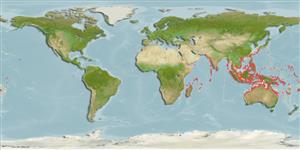>
Mulliformes (Goatfishes) >
Mullidae (Goatfishes)
Etymology: Parupeneus: Latin, parum, parvum = small + Peneus, the name of a river.
More on author: Shaw.
Environment: milieu / climate zone / depth range / distribution range
экология
морской; солоноватоводный ассоциированный с рифами; пределы глубины 10 - 30 m (Ref. 48636). Tropical; 19°N - 23°S, 28°E - 150°W
Indo-Pacific: Yemen coast of the Gulf of Aden and southern Oman, along the east coast of Africa to Port Alfred, South Africa (33°S), east to the Caroline and Somoan islands; southern Japan to southern Queensland.
Size / Вес / Возраст
Maturity: Lm ? range ? - ? cm
Max length : 45.0 cm TL самец/пол неопределен; (Ref. 48636); common length : 35.0 cm TL самец/пол неопределен; (Ref. 48636)
колючие лучи спинного плавника (общее число): 8; членистые (мягкие) лучи спинного плавника (общее число): 9; колючие лучи анального плавника 1; членистые (мягкие) лучи анального плавника: 7. Diagnosis: Pectoral rays 16 (rarely 15 or 17). Gill rakers 5-7 + 18-21 (total 24-27)> Body depth 3.25-3.75 in SL; head length (HL) 2.9-3.25 in SL; snout length 1.65-1.95 in HL; barbel length 1.3-1.5 in HL. Longest dorsal spine 1.5-1.8 in HL; penultimate dorsal ray about equal to last dorsal ray in juveniles, 1.05-1.2 in length of last dorsal ray of adults; pectoral-fin length 1.35-1.55 in HL; pelvic-fin length 1.3-1.5 in HL. Body greenish brown to reddish brown dorsally, the scale edges narrowly dark, shading to whitish or pale pink ventrally, with a nearly round black spot as large or larger than eye on side of caudal peduncle, two-thirds of which lies above the lateral line; a large, horizontally elongate yellow spot (sometimes partly white) on lateral line below interdorsal space; barbels white; irregular pale blue lines extending anteroventrally and dorsoposteriorly from eye; second dorsal and anal fins with irregular oblique pale blue lines; caudal fin yellowish gray with faint blue lines paralleling rays; peritoneum dark brown (pale brown to white in other species of the genus except Parupeneus barberinus) (Ref. 54393).
Inhabit shallow sandy or silty areas (seagrass substrata) of coastal and inner lagoon reefs (Ref. 9710, 54393). Occur singly or in schools (Ref. 5213). Large adults usually at moderate depths to about 30 m (Ref. 48636). Feed on benthic invertebrates; the diet including small crabs, amphipods, shrimps, small octopuses, polychaete worms, and small fishes (Ref. 54393). Marketed fresh (Ref. 5284).
Life cycle and mating behavior
половая зрелость | размножение | нерест | икра | Fecundity | личинки
Randall, J.E., 2004. Revision of the goatfish genus Parupeneus (Perciformes: Mullidae), with descriptions of two new species. Indo-Pac. Fish. (36):64 p. (Ref. 54393)
Статус Красного Списка МСОП (Ref. 130435)
Угроза для людей
Harmless
Использование человеком
рыболовство: коммерческий; объект спортивного рыболовства: да
дополнительная информация
ссылкиаквакультура (рыбоводство)особенности рыбоводствастепень растяжениягенетикаElectrophoresesнаследуемостьболезниобработкаNutrientsMass conversion
инструменты
Специальные отчеты
Скачать в формате XML
ресурсы в Интернет
Estimates based on models
Preferred temperature (Ref.
123201): 26.2 - 29, mean 28.2 °C (based on 442 cells).
Phylogenetic diversity index (Ref.
82804): PD
50 = 0.5000 [Uniqueness, from 0.5 = low to 2.0 = high].
Bayesian length-weight: a=0.01175 (0.00956 - 0.01444), b=3.10 (3.07 - 3.13), in cm total length, based on LWR estimates for this species (Ref.
93245).
Trophic level (Ref.
69278): 3.5 ±0.37 se; based on food items.
устойчивость к внешним воздействиям (Ref.
120179): средний (среднего размера), минимальное время удвоения популяции 1.4-4.4 года (Preliminary K or Fecundity.).
Prior r = 0.67, 95% CL = 0.44 - 1.01, Based on 2 stock assessments.
Fishing Vulnerability (Ref.
59153): Low to moderate vulnerability (35 of 100).
Nutrients (Ref.
124155): Calcium = 29.3 [14.0, 66.8] mg/100g; Iron = 0.276 [0.137, 0.641] mg/100g; Protein = 18.2 [14.9, 21.2] %; Omega3 = 0.12 [0.07, 0.23] g/100g; Selenium = 44.7 [21.2, 118.3] μg/100g; VitaminA = 178 [31, 850] μg/100g; Zinc = 0.611 [0.357, 1.147] mg/100g (wet weight); based on
nutrient studies.
